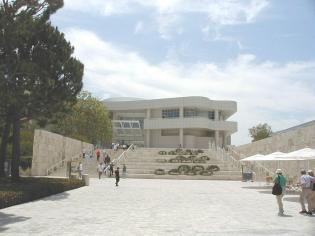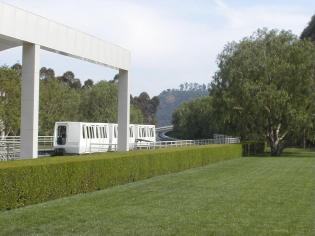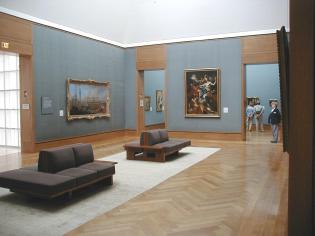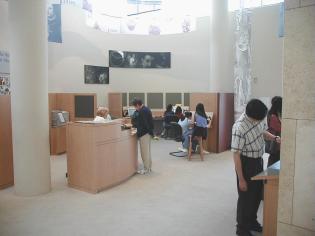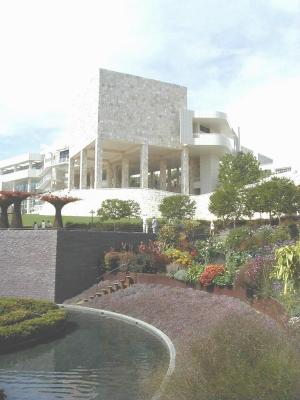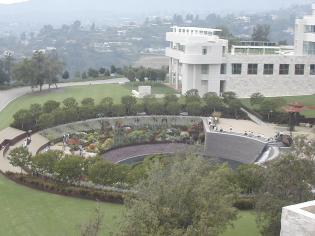


|
The Getty
Center: Meier's Marble Masterpiece Perched high on a hilltop off the 210 Freeway in Los Angeles is an awesome sight-a massive marble and glass building that is the new home for the J. Paul Getty Museum at the Getty Center. The site looks out over downtown LA, and on a real clear day you can see all the way to the Pacific Ocean. If you haven't yet visited, now is the time!
When the museum opened two years ago, many people were discouraged from visiting because of traffic nightmares and throngs of fellow art lovers. On our recent visit, we found the museum far less crowded. Now it's possible to spend an entire day leisurely looking at the Getty Museum's marvelous art collection. The Site After parking, all visitors ride a free tram up to the Center's main building complex. You can also walk, but it is a fairly long jaunt and you might want to conserve your energy for all the walking you'll do at the museum! There will be a conveniently placed Map & Guide available to you when exiting the tram-take one, it's an extremely useful tool to help you get around the complex.
The first thing you may notice is that there are several different buildings at the Center. It is important to know that the Getty Center is more than just a museum; it also includes the Getty's Research and Conservation Institutes. Be sure to take some time exploring your surroundings and (if it's not too smoggy) the spectacular view. There has been much written about the architecture of the Getty Center and many visitors begin with an architectural tour provided by one of the museum's well-trained docents. However, if it's a sunny day make sure you wear sunglasses! The architect, Richard Meier has created beautiful buildings, but all the marble and white enameled aluminum is incredibly bright in the full sunlight.
Museum Collection The museum has four separate pavilions that contain art collections which span from ancient Greek vases to 20th century photographs. Their permanent collection includes several noteworthy paintings such as Van Gogh's 1889 Irises and Pontormo's Portrait of a Halberdeier, 1528. They also have a wonderful assortment of photographs and works on paper.
Perhaps the J. Paul Getty Museum is best known for their enormous collection of ancient Greek and Roman art. Only a small portion of this collection can be seen at the Getty Center, however. Originally this part of the museum was located at Getty's Roman Villa in Malibu, which for the moment is still going through extensive renovations and will reopen in about a year. If you are interested in illuminated manuscripts, you will be more than satisfied with the quality of medieval and Renaissance manuscripts at the Getty Center. The museum is establishing itself as the premiere collector of illuminated manuscripts on the West Coast. The Getty's collection is rivaled only by the Pierpont Morgan Library in New York City and the Walters Art Gallery in Baltimore. Learning Opportunities The Getty Museum provides a wide variety of learning opportunities for its visitors. There are two theatres in the Museum Entrance Hall where new visitors can view an orientation film. In addition, a self-guided audio tour of 250 works in the museum's collection is available for a $3.00 fee. Especially useful are the Art Information Rooms located in each of the museum's pavilions. In these rooms visitors can further explore how art is made. For example, in the North Pavilion, we were able to touch real vellum that manuscripts are made from and take a closer look at the materials used by medieval artists, such as gold leaf and lapis lazulis. The Art Information Rooms also feature computers that provide an interactive experience for visitors. This area seemed to be a particularly popular spot for students (one of the docents, with a weary smile, told us that the students were using the computers to search for answers to a class assignment instead of looking at the art in the museum to discover the answers for themselves).
If you have questions about any work in the collection, don't be intimidated to ask. We found that all the museum docents and staff were exceptionally helpful and courteous when answering our questions. The security staff is also friendly and knowledgeable. Time Out When you're ready to eat, you have several options. A restaurant offers lunch and dinner, but reservations are required. More casual alternatives include a large cafeteria and a café that overlooks the beautiful Central Garden.
After your break, be sure to take a closer look at the Central Garden designed by artist Robert Irwin. There are 24 acres of gardens at the Center to explore! In addition to the abundant flowers, plants, and trees found here, the Gardens also include rocks and boulders that have been carefully placed to enhance the effect of the stream that rushes through. The Getty Museum describes the stream as a "sculpture in sound." The day we visited was very warm, so it was refreshing to spend some time watching and listening to the water stream down and around the rocks.
Museum Information There is no admittance fee to visit the museum, but visitors are required to make a reservation to park. The parking fee is $5.00 per car (regardless of how many people you can fit into your vehicle). If you, or someone in your group is a college student, you don't need a reservation to park. Just show the parking attendant your student I.D. card and pay the parking fee. If you want to bring a picnic, the Getty Center offers a picnic area in a garden setting near the tram and parking garage. This was our third visit to the Getty Center since it opened and we still haven't seen everything the museum has to offer! There is so much to do at the Center that you could easily spend an entire day there. So when you plan your visit, be sure to allow enough time to look at the art, savor your surroundings, and enjoy the view. For more information, consult the Getty Center's web site. |
